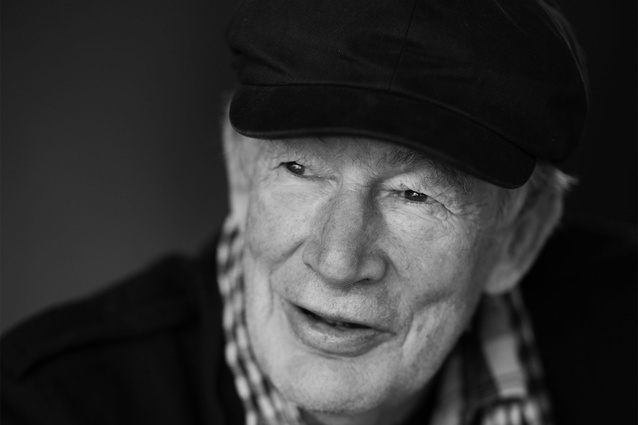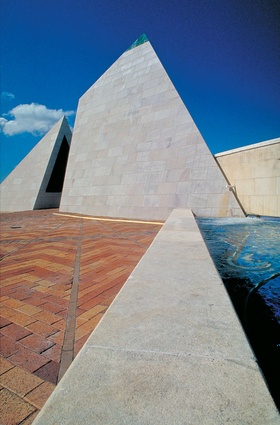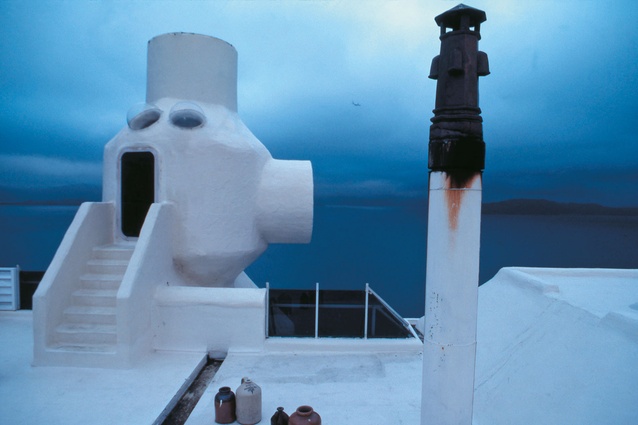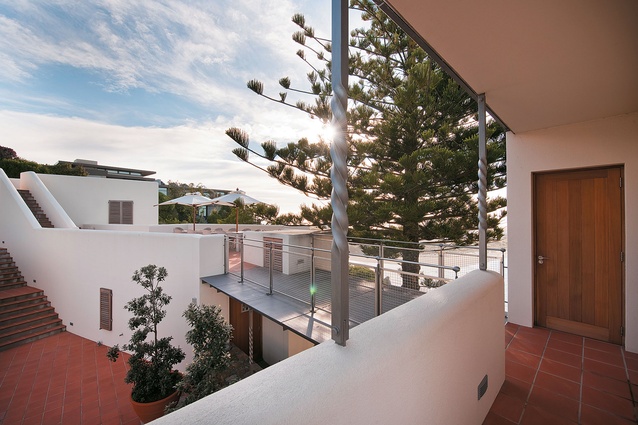Up close & personal: Ian Athfield
A new book and exhibition about his architecture practice give an insight into the projects and passions of a counter-culture creative. Nicole Stock asks what's next for Ath?
Urbis: You’ve been interested in architecture from a young age?
Ian Athfield: Well, my brother and I were both adopted into a working-class family and we lived south of the railway tracks in Christchurch which is significant, because it’s always hard to move beyond that. And my parents used to take in lodgers and one of them was a school teacher from Palmerston North. [When I was] seven, he suggested to my parents that I could be an architect. He also suggested to mum that my brother was musical, so my mother brought us up to think that one would do music and the other would do architecture. So from the age of seven, I was given the thought of architecture and I stuck to it. She said my maths was very good and I could draw well. And my brother, after much persuasion and my mother learning the mandolin, was able to pick up the guitar and became the lead guitarist in the Max Merritt band, which was one of the big rock bands of the ’50s; he earned three times the amount of my dad by the time he was 13.
U: Christchurch would have been quite a richly developing urban scene at the time.
IA: Well, I don’t even think you thought about that. I suppose what influenced me the most, and still influences me and frustrates me, is suburbia. We lived in the typical suburban environment and, because Christchurch is so flat, you get to know one or two neighbours very well, or at least my mum did. She was a slightly difficult woman; she’d get to know one of the neighbours and my dad would cut a door in the wooden fence between mum and her chosen neighbour and, two or three years later, he would have to nail it up again, and we’d open the door up to another neighbour. You know, it was a strange place to live and one didn’t mix terribly further than the immediate neighbourhood.
U: How did you start getting some of your earlier commissions?
IA: Well, I suppose, I had nearly finished a diploma in architecture here, and then, no, it was 1963, we got married in 1962, so it’s our 50th wedding anniversary this year. Amazing… and so, in 1963 I was finishing at the school of architecture. And I went to work at a firm called Stephenson and Turner, which is still around, and I was there for about four weeks, when I was contacted by the architecture school. Structon Group Architects was a firm of about 78 people which was an engineering and architecture firm and had been criticised severely for their design, which wasn’t really too bad, but they wanted a new designer in their firm, so a couple of people were nominated from the school of architecture. They gave me a position and also a promise of a partnership within three years of me working there, and I became a partner at 25 years old. And the rest of the partners… the next youngest was 41, so you know, I was a little bit of a problem for the firm because some of the partners were 65, and I tried to introduce a retirement policy for the 65-year-olds, which wasn’t taken very kindly.
U: What would you think of that now, if someone in your firm tried to introduce that for you?
IA: I would love it. I mean, I do have a retirement plan, and I have been trying to ease my way out, and I do have exceptionally good directors in the firm, so I am really, really lucky. So hopefully, by towards the end of this year, I will be able to phase myself out of the firm, but I will continue working for the office. So, anyway, the day that I turned 28, I was fired from the partnership. But by the afternoon I had a number of their clients, and then I had the bailiffs come round and give me a court order to ask me to desist from soliciting clients. But I was on my way by then. So the next day I started work from my office at the house. I didn’t really look back but, at the same time, I was quite frustrated by the inability to do the sorts of things that I wanted to do. It’s fair to say that we did well for the first couple of years and then, in ’69–’70, there was an international monetary crisis, which is what is here now, and I remember, by ’71–’72, we were labouring. We were painting and bricklaying; we would go out and do those sorts of jobs.
U: What is the significance of actually building something with your own hands as an architect? Do you think all architects should be involved in that?
IA: Yes, look, I think it’s very very important. I know the ones that have built for themselves, or for their families, generally do better than the ones who haven’t. And the ones who haven’t, they move into teaching or project management or computers. The history of architecture, like the history of art, is actually a very good subject for people to take, so it’s certainly not mandatory for the person who builds, but it’s certainly helpful to know how things are put together. Computer technology can give you a bit of a hike or a bit of a kick but, in the end, you have to put something together that works quite well, and you have to know the process of building. I suppose we are assisted amazingly by computers but, on the other hand, we are at the mercy of them. The software programmes don’t actually do that slow process of thinking and taking in all those areas that you need to take in before you sort of draw the chosen line. It decides the line is more important than other people’s minds are. I say that architecture is the pencil of the joint mind. It’s never just your mind that influences the final product.
U: What is an architect’s role?
IA: I think it’s more about the process of building and the relationships you form to build things. One of the interesting things we’ve been doing just in the last three or four days, round north Auckland, is looking at the decay, looking at new settlements and I’m just appalled at the relationships formed between buildings: basically the space you have left between buildings. Often the space between the buildings you build is more important than the building. And once you set that pattern, everything you start building just competes with each other. And they compete with each other through materials, they compete with each other in planning laws, they compete with each other because the roads cease to be places where you meet and become places where you drive. We have to start thinking about the patterns of our cities again. Not getting rid of cars, because many of the answers are about replacing the cars, but that’s a bloody stupid idea; we’re always going to have personal transport, and that’s important to have, but then actually modelling that in quite a different way.
U: How do you start your design process?
IA: I suppose there’s quite a bit of talking. One doesn’t draw the final image for some time after you’ve started. Being a good listener is important. And I insist that anyone who works with me looks at the complete context of what we are doing. You need to look at the neighbourhood, if we’re doing a school, and see how many people take the kids to school on a given day, and what actually happens in a place. And once you’ve actually got a pattern, and you’ve drawn the things around the area that you have to concentrate on, you’re able to actually say, look, if we do this, that will affect that.
U: A lot of your projects over the years, in particular your own house, have become iconic objects in the landscape. Was your house an experiment?
IA: Yes, very much so. It was more an experiment for the neighbours who actually found it very difficult. It asks as many questions as it gives answers. And that’s really important. Kids love it. Kids who don’t have any set ideas, they really enjoy it. They play on the roof, there are accidents waiting to happen, there are a great many number of spaces, you can get lost, you can be by yourself, or you can be with a group of people. We do actually have a lot of people loving and working in it, which means that it works from a financial position, and it’s big enough to challenge some of the frustrations of suburban dimensional planning. And it also offers enough different spaces that hopefully other people will take it up in the next two or three generations and respect it and do something else with it. It’s not important that it’s always a residential place or an office, you know; it could be a private hotel or restaurant. If you actually take it, if it were 10 times bigger and housed 500 people, you’d be getting closer to the model that would get people to change the suburb… which means that you don’t actually remove the suburban pattern, but you absorb the suburban pattern, so it’s one pattern over the other.
U: You were well known for your counter-culture architecture, but you also work with big business and councils. How do the two work together?
IA: I suppose I’m mature enough to know that when I am doing a project that actually makes money, I can influence the things that are really important that other people might not have an opinion on. I talk about ideals, rather than draw them. Many architects will draw things very quickly but, just by changing the way other people think, you can change the spatial thinking of other people without dominating them, which has really been quite good. It’s that background which is quite helpful. The big [issues] are about space, the private realm, and the interior space between the public space and the private realm, and I think that’s the most important space we have to deal with, and the most challenging to talk thoroughly about.
U: What are your thoughts on the way Christchurch’s rebuild has been managed?
IA: Christchurch has been so bloody frustrating because you’ve got the engineers on the one hand and the building huggers on the other, and you’ve got to… and I was put in the place where I thought I could help, but I was just thrown aside. It’s been a miserable sort of existence for the last 18 months, so I’ve sort of stepped aside, and we’ll pick up the work that falls off the table of the greedy people, whoever they are. But that’s not what Christchurch should have been about. It’s just an important international event that should have been answered in a different way: a spoken vision in the first place, and a careful development from that point on. There’s been no spoken vision; there’s been no suggestion that people, whoever they are, who are affected by it, will actually be considered and that’s been a major problem. Christchurch had that great opportunity to sort of look at a different type of city. You know, it is probably a string of villages, but it had to be looked at by a string of minds working together, not engineers battling each other to see how much of the building should come down.
U: What is important for the future of architecture in New Zealand?
IA: I think it would be to be listened to. Absolutely essential. And to be able to work with others. To understand it’s not a them-and-us situation. To make things work, actually to make this country work, to think about how urban areas work in relation to the countryside is really important. How the computer era will change the way we think about ourselves, how we live, how we live in relationship to other people and the personal privacy of each individual have to be understood and respected, which is a really hard thing to do, because each person has a different need for privacy; but, the more we actually understand that, the more we actually understand ourselves.














